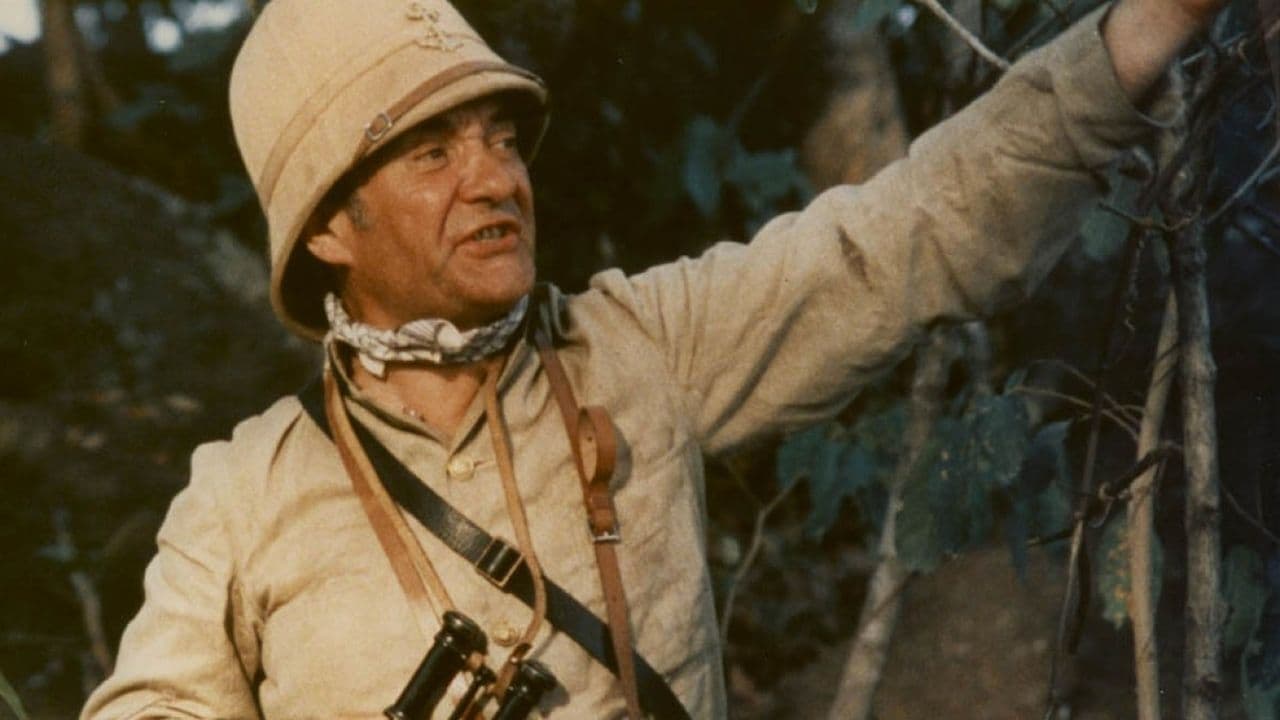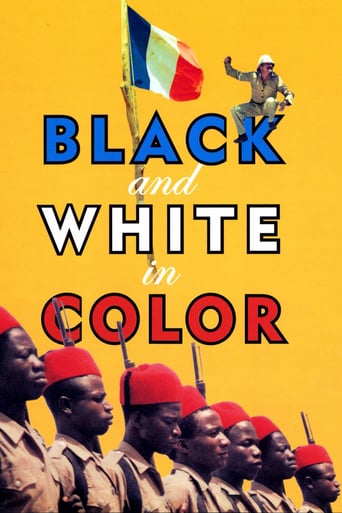



This is How Movies Should Be Made
Dreadfully Boring
After playing with our expectations, this turns out to be a very different sort of film.
View MoreThe movie is made so realistic it has a lot of that WoW feeling at the right moments and never tooo over the top. the suspense is done so well and the emotion is felt. Very well put together with the music and all.
View MoreBlack and White in Color is a 1976 film about the unctuous specter of war and its curious effects on the small African colonial community of Fort Coulais. The white colonists of the town largely consists of wholesale merchants the Rechampots (Dufilho, Legros and Doll), the sexually frustrated Simon's (Monnet and Rouvel), two bumbling Catholic priests (Berling and Boignan), a permanently drunk sergeant (Carmet) and young geographer Hubert (Spiesser). It is through a care package sent to Hubert that the townsfolk discover France has been at war with Germany for a little over a month and in a patriotic fervor decide to take on the nearby settlement in German Togoland. To do this however they must coop the large black population.Exploding onto the scene as a powerful calling card for director Jean-Jacques Annaud, Black and White in Color benefits from some sly and surprising comic set-pieces. Those expecting the dour humorlessness of Enemy at the Gates (2001) will instead find moments of genuine mirth, plain and in the open among the noxious absurdity of war. In one scene palanquin carriers chant clever songs as they labor to bring the priests to their destination. While whites hear them and think they're gibberish, the locals know they're singing about the quality of their passengers. On many occasions the white colonists celebrate their piddly (and few) successes while black Catholic converts Caprice (Barrier) and Assomption (Atchory) shake their heads in disbelief; muttering to themselves "ugh, white people."There are times when the light-hearted humor threatens to sabotage the themes of the story from within. Thankfully we have the character progression of the young Hubert Fresnoy who at first seems the least enthused about battling the Germans. As the only learned member of the colonists, Hubert reluctantly leads the defense of Fort Coulais and the Sisyphean task of taking the neighboring German settlement. When we first meet him, he's drafting a letter to a school friend. In it he writes "I dare say, that in many respects the natives are not far from meriting the honored name of men," pitting him as the most enlightened of his compatriots. Yet war takes a toll on idealists as both Hubert and the audience come to realize. A toll that might just rob him of his humanity.If ever there was a character that best exemplifies the goals of the film it'd be Jacques Dufilho's Paul Rechampot. While being the most outspoken and vain of the white colonists, he's also the most selfish, going so far as to bury cans of sardines and other supplies so their conscripted army won't take them. Bearing a thick, angry mustache, fierce eyes and brimming with hubris, the man against the elements superimposes a thesis of absurdity; like herding cats or confidently pissing in the wind.What's ultimately missing from Black and White in Color is serious input from the locals themselves. Shot entirely in Cote d'Ivoire, the film feels like a satirical screed on war, religion and colonialism which, while well argued, nevertheless feels like it could have used at least one strong black character. Assomption gets a moment to shine as he gatekeeps for Hubert but we never get to really see the horrors of war up close from the subjugated perspective; from the soldier's perspective. So many men die as a result of hostilities yet the film's preoccupation with the white settlers blunts what could have made for a more damning film.Thankfully, Jean-Jacques Annaud's clever direction and a few choice satirical images sure to stick with you make Black and White in Color worth a gander. Sure it might be plagued with one too many "white- guilt chic" moments, but at least you know it's heart is in the right place.
View MoreThe point here is that, in a clash of foreign colonial powers, the locals inevitably get the worst of it. This point is made early on and gets little further elaboration as the drama plays out. Giving the Oscar for best foreign film to a movie which was, let's be honest, a decent enough but obvious and not unusually clever satire on a serious topic (WWI), had to be some misguided exercise in political correctness before such nonsense had been given a name. Yes, it is fairly remarkable that a film with international appeal could be financed and shot in a place like the Ivory Coast. We get this. But an award for BEST foreign film, at a time when many national cinemas (Germany, France and Italy especially) were churning out a pretty impressive product, seems like tokenism. There. I said it. Go ahead and be offended.The film itself is watchable enough but ordinary. The pacing is slow, the characters are not particularly sharply drawn, and the plotting - mostly a series of military misadventures and misunderstandings - is nothing really clever. It works well enough, but had me neither slapping my knees in merriment, nor nodding in acknowledgement of its cinematic skill. If Hollywood had cranked out something along the same lines we would have expected a higher level of creativity. It has unexpected moments of simple entertainment thanks to some old-fashioned knockabout comedy, but even this is executed with no display of unusual skill on the part of the film's makers. Everything manages to hold together well enough and move the story along - the cinematography of the African locations looks good - but there is just nothing here that is special enough to elevate the project above the realm of the merely good and giving it such a prestigious award as if it does seems dishonest. Watch it, but don't let the Oscar voters snow you. It's an okay movie, and an honest attempt at creating international cinema in an unexpected place. It's just not THAT GREAT.
View MoreWhat day should be chosen to attack the Germans just up the river, ponders the French in flea-ridden Ft. Coulais, in the Ivory Coast? "You can't go wrong choosing the Lord's Day," urges one of the two priests, with the other nodding enthusiastically. Please note that elements of the plot are discussed, but nothing that also isn't mentioned on the back-cover of the case and in the accompanying insert Black and White in Color tells the story of a motley group of Frenchmen, including a few shopkeepers, at a colonial outpost in Africa who learn belatedly that World War I is underway. Since a German outpost, with three Germans, is just a few miles away, La Gloire and honor dictate an attack. Of course, the real fighting will be done by hastily recruited natives on both sides. The fort's young teacher, Hubert Fresnoy (Jacques Spieser) had heard that there is a sensible German and says he wants to try to negotiate. With La Gloire, that would be impossible. The shopkeepers demand French honor be sustained with an immediate attack on the Germans with whom they'd been trading (and unknowingly sharing their wives) just days before. And off they go. The shopkeepers, two priests and two wives are carried in palanquins by natives. The hastily recruited and untrained native soldiers are armed with old rifles and some slightly damp powder. They're led by the tired and realistic Sergeant Bosselet (Jean Carmet) only three years from retirement. The teacher reluctantly tags along. And they all -- well, the whites -- stop for a picnic just before the battle starts. War, they appreciate, can be great fun as well as a source of great pride. Unfortunately, the Germans have machine guns. As the native troops stagger back, the whites hastily pack up the food and dishes and head quickly back to the fort. Surrender seems the logical next step to the shopkeepers, even though no one has yet seen a German. But La Gloire prevails: No surrender...as long as the Germans stay away! Now the amusing part really begins. The teacher, who had been ridiculed by the shopkeepers as being all brains and no heart, decides to step in. He convinces the sergeant, who needs all the brains he can find, to back him up as he plans for the defense of Ft. Coulais. Before long we begin to notice that the teacher is not only training the troops, he is turning the fort's colonial society on it's head. The casual corruption of the self-inflating shopkeepers is exposed. Positions of authority are being given to natives. The teacher's mistress, a black woman, accompanies him to another picnic, and this time the wives and shopkeepers find themselves shaking her hand. All good things come to an end, of course, and so does World War I. A British company led by a Sikh captain marches into Ft. Coulais with bagpipes playing to inform them that the German colony is now a British colony. The war is over; the next-door enemy has become an ally. And the teacher, a Socialist, who was well on his way to becoming a benevolent and anti-colonial dictator, is last seen wandering off with his German counterpart, who is also a Socialist. This was director Jean-Paul Annaud's first film. It's a wonderfully sardonic, amusing movie about hubris, patriotism and racism, and surprisingly gentle. Those who believe that "glory" can come without a steep price, who believe war is a great adventure as long as it's experienced at a distance, who believe whites are intrinsically superior, all take their share of ridicule. "White men are stronger than black men. Why?" shouts a priest. "Because they have a better god!" comes the well-rehearsed answer. Of course, in his own language one native says to another, while the white sergeant slaps away an insect, "Didn't I tell you white men attract flies?" In one quick scene a native who had been facing Mecca and praying quickly disappears into his hut and reappears wearing a cross just as the priests arrive.
View MoreThis movie, "Black and White in Color" tells the story of a French colony in Africa affected by the German threat during WWI. Desperate for manpower, the local French officials recruit unwilling native Africans to fight against a professional German army without any knowledge of modern warfare. This proves to have disastrous consequences.Thanks to the brainchild of a young geographer named Hubert Fresnoy, France is able to defend its African colony against the German threat. The movie is vivid but rather dull in some parts. Gillo Pontecorvo's "The Battle of Algiers" is a much better film despite running slightly longer.
View More